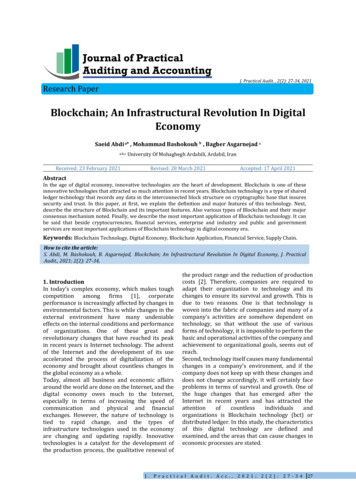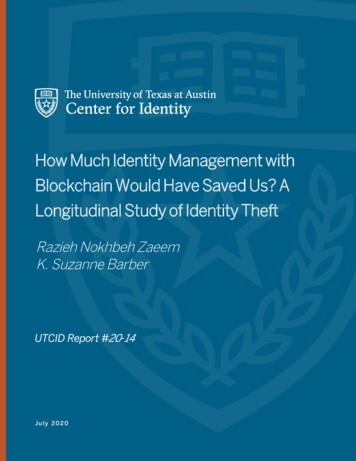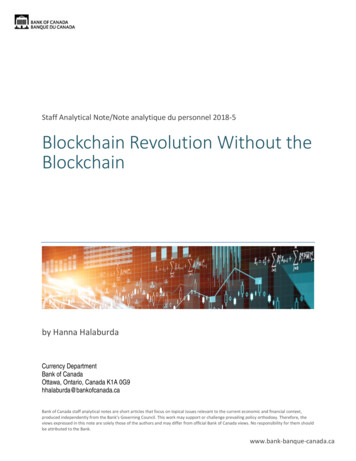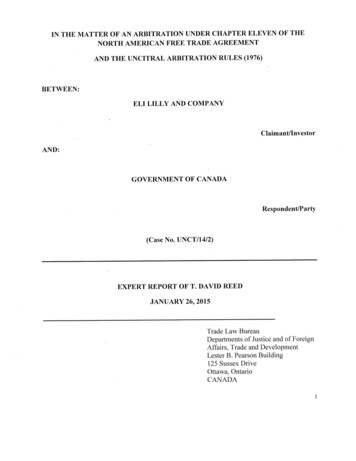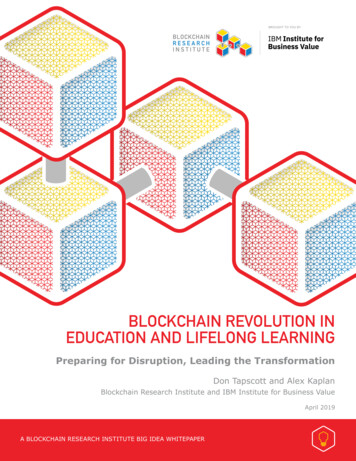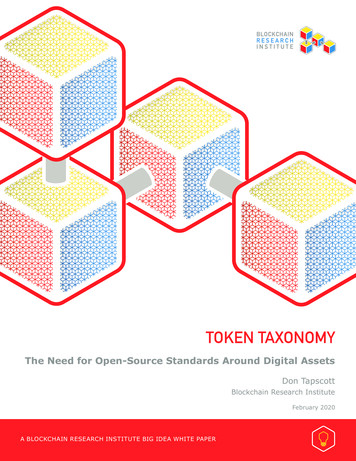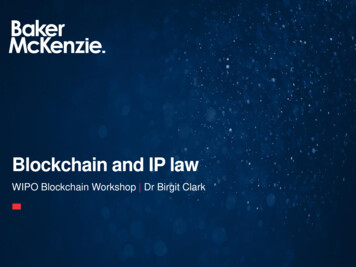
Transcription
Blockchain and IP lawWIPO Blockchain Workshop Dr Birgit Clark
Confused by jargon?
Replacing the ituation: Amy needs to send money to BobAmyAmy's BankBob's BankBobBLOCKCHAINAmyBob
How a blockchain transaction worksURuser and recipient wish to conducta transaction (i.e. send data,cryptocurrency, contract, etc.)cryptographic keysassigned to User and Recipienttransaction is "broadcast" toand "verified" by adecentralised P2P network("nodes"); using algorithms "miners" in the network "validate"the transaction creation of a new date stampedblock ("proof of work") network balances updated new block added to theblockchain (arguably) immutable andtransparent record oftransaction cryptographic signature assignedTransaction complete
ModelsModel 1Previous systemsA centralised systemModel 2Public blockchain(permissionless)An open network that anybody canaccess. The digital ledger oftransactions is shared, transparentand run by all participantsModel 3Private blockchain(permissioned)The preferred option of mostregulated entities. It is a privatesystem which controls access tocertain invited participants.
Use casesApplications across etailEMIPublicsectorReal EstateNature Payments Supply chain Digital identity Reconciliation Record keeping Compliance Securities Asset management Smart contracts
Applications in IPPatentsCertificationTrade marksSupply ChainTrackingTrade SecretsEvidence ofCreatorshipProvenanceAuthenticationSmart IP Rightsand RegistriesEvidenceof tContractsDigital RightsManagement
"Smart" IP rights and registriesCentralized solution - run by the IP office as an accountable authority?One global IP registry – a myth?Replacing or supplementing the traditional IP register databasesRobust and trustworthy proof of events in the life of a registered IP rightSaving time, resources and moneySimplifying IP audits and due diligenceLicensing, assignments, chain of title Issue of confidential data Open or private blockchain
Evidence of useEvidence of use of a trade mark (e.g. evidence of acquireddistinctiveness/secondary meaning; defending non-use revocations;renewal; incontestability, etc.)Data updated and notified to smart IP Registry virtually immediately onthe occurrence of a verified eventLower the burden of cost and administration collecting relevantevidenceIssues: confidentiality of sensitive business data (private vs publicblockchain); interoperability of blockchain solutions
Certification and collective marksCollective marks: for use by a specific group of enterprises, e.g.members of an associationCertification marks: for use by anybody who complies with thestandards defined by the owner (i.e. products meet certain establishedcriteria or standards, e.g. Woolmark)xFake certificates can almost immediately be identifiedEntity that applies for registration is considered "competent to certify"the productsIssue for both: public nature of traditional open blockchain;
Evidence of creatorshipEnforcement of unregistered IP rights ("bridge the gap"): difficulties ofproving ownership of unregistered trade marks, unregistered designs,goodwill, copyrightEvidence of conception, use, status, qualification requirements (suchas originality and the country in which articles made to design werefirst marketed)Original design document and details of designer on blockchaincreate timestamped record and evidenceDeterrent for infringers"Pioneer" platformsCf. authentication of "storytelling" products
China – ahead of the gameWe should not reject or impose higher standards simply becauseit involves new technology Provided that the technicalverification is consistent and other evidence can be mutuallyverified, such electronic data can be used as evidence for theinfringement in the (copyright) kqQChina's Supreme People's Court:evidence stored and verified on blockchainplatforms may be used in legal disputesheard by the three internet courts inHangzhou, Beijing, and Guangzhou (cf.notorisation by public notary)
Smart Contracts and DRMSmart contractsNo universal definitionProgrammable transactions — computerised transaction protocols thatrecognise fulfilment of conditions and automatically execute terms of acontract (cf. "Oracles")Digital Rights Management: (micro-)payments to IP owners in real timeDelay in payments issue
Anti-counterfeiting and enforcementScannable tags or chips immutable information(cf. QR codes and NFC tags)If genuine products are embedded with original tag, then its absenceor incorrect/duplicate data will be an easy way for customs to checkwhether a product is counterfeitEducate and involve customs and customersRethinking customs programs to prevent global trade in counterfeitsEliminating fakesProvenance AuthenticationEngaging customers in the process of verifying whether a product isgenuine – won't change attitude of those that intentionally buy fakes?
Supply Chain and TraceabilityFragmented supply chains, parallel imports, grey goods, selectivedistribution networksLegal traceability requirements (e.g. Falsified Medicines Directive(FMD), US Drug Supply Chain Security Act (DSCSA)Tracking the movements of a physical product, where it was placedon the market, shipped etc.Example:monitoring the authenticity of ingredients during all stages of production:raw material sourcing, manufacturing of the active pharmaceuticalingredients and the manufacturing of the final products
Tracking Goods in the Supply ChainWhy (private) blockchain?How does it work?Remaining problems: Obtain a secure record ofthe entire supply chainInformation on when andwhere a product is made,processed, shipped,storage conditions etc.Speed up administrationValuable supply chaininformation not visible tocompetitors At each step, all partiesverify the existence andconditions of goodsInformation is digitallylinked to goods Every party at every stepmust be involvedDifferences between "realworld" and digital worldWho pays and what willincentivise everyone toplay their part?
Trade SecretsIncreasingly common for businesses (especially SMEs) to protecttheir inventions as trade secretsAlternative to innovation patentsDefinition:information which is (i) secret, (ii) has commercial value and which (iii) has been subject toreasonable steps to keep it secret (cf. Article 39 TRIPS, US Defend Trade Secrets Act 2016,EU Trade Secrets Directive,) – only valuable to they extent they are kept secret;Proof that information has been kept secret in case ofmisappropriation (encryption, hashing, proof of existence)Means of securely sharing information with third partiesBlockchain as secure means of sharing trade secrets: "smart NDAs"Untested in courts
Who owns blockchain?PatentsTrade secretsHybridapproachesTrade marksOpen sourceapproachCopyright Selecting and managing relationships with providers Contractual considerations
Will blockchain live up to the hype?HURDLES TO LARGE SCALE APPLICATION1High cost pertransaction4Compatibility andstandards2Time delay5Public's confidence intechnology and participants3High energy usage6Anti-trust / privacy concernsBut solutions are being developed Addressing bandwidth issues by reducing computing power required by each usercomputer / node Addressing storage issues by using hybrid models, in which not all data is stored onthe blockchain (storing less significant data "off chain")
Relevant tracking applications: examples01 Provenance: "Everledger"/ consumer02 Marketingengagement: "Babyghost" Verify origins and ownership of diamondsNumber on diamond / features of diamond andownership on a blockchain RFID tags in clothing interact with blockchainAllowed clothes to 'tell their own story' –those scanning tag could access detailsabout the designPossible application in sustainabilitymessaging, promotions, authenticity checksRFID / QR Code technology alsodeveloping fasthttps://www.youtube.com/watch?v GAdjL-nultI
Relevant Tracking Applications03 Anti-counterfeiting04 Parallel trade Interaction with RFID tags / other identifiers inphysical worldPotentially help identification by customsBenefit of a global solution Identify where diversions out of legitimatesupply chain occurTrace origin of productsConsumer trust / reliance on warranties etc
Questions
Baker & McKenzie LLP is a member firm of Baker & McKenzie International, a global law firm with member law firmsaround the world. In accordance with the common terminology used in professional service organisations, reference to a"partner" means a person who is a partner, or equivalent, in such a law firm. Similarly, reference to an "office" means anoffice of any such law firm. This may qualify as "Attorney Advertising" requiring notice in some jurisdictions. Prior resultsdo not guarantee a similar outcome. 2019 Baker & McKenzie LLPbakermckenzie.com
PROACH Amy Amy's Bank Bob's Bank Bob BLOCKCHAIN PROACH Amy Bob BLOCKCHAIN. How a blockchain transaction works user and recipient wish to conduct a transaction (i.e. send data, cryptocurrency, contract, etc.) cryptographic keys assigned to User and Recipient transaction is "broadcast" to and "verified" by a decentralised P2P network ("nodes"); using algorithms "miners" in the network "validate .
